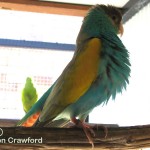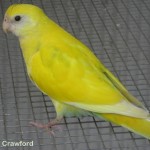 For many years we have enjoyed the pleasing experience of keeping and breeding the Hooded parrot – Psephotus Dissimilis. The early seasons display has the cock bird showing off his magnificence to his unsuspecting hen while he constantly regurgitates to win her affections. And then, as if it was prearranged with nature, the natural occurrence of the early seasons thunderstorms trigger their hormones, bonding their excitement for what lies ahead in the coming breeding season.
For many years we have enjoyed the pleasing experience of keeping and breeding the Hooded parrot – Psephotus Dissimilis. The early seasons display has the cock bird showing off his magnificence to his unsuspecting hen while he constantly regurgitates to win her affections. And then, as if it was prearranged with nature, the natural occurrence of the early seasons thunderstorms trigger their hormones, bonding their excitement for what lies ahead in the coming breeding season.
I remember when we first started with the hooded parrot trying to keep things as close to their natural breeding behaviour as possible so we would spend a whole weekend just before the breeding season searching the gullies and bushlands in the local countryside for a white ant nest of the right type that was still active and free of black ants. But times have sure changed and we have a lot less free time available in our busy lives today, so we keep it as simple and practical as possible. Small home-made insulated nest boxes have been just as acceptable as the white ant nest, taking up considerable less room while keeping things neat, tidy and more hygienic.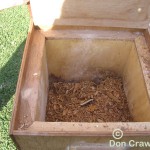
Once the nest box is in place the behaviour of the breeding pair is very interesting indeed. To start them off I fill the nest three quarters full with suitable nesting material. The hen shows no patience at all, straight in the nest and on the job. Quite amazingly she scratches and throws the discarded material out of the nest and up to a distance of 60cm away from the nesting chamber. This is an incredible achievement knowing that the spout on the nest box has a diameter of 5cm and is approximately 7cm long.
This digging of the nesting material by the hen also stimulates the cock bird for when she comes out on the nest for a rest; in he will go as to inspect her hard labours. On leaving the nest he is totally excited and will immediately display to the hen as if to show his appreciation of a job well done. Now that the preliminaries are over the cock will seriously start to feed the hen, and soon after they will be seen mating. Once the hen starts to lay, she will produce one slightly round white egg every second day. The clutch of eggs may range from three to as many as six, depending on the age of the hen. Young hens normally have smaller clutches. 
A large majority of problems incurred during the breeding season for most birds can be related back to calcium. Therefore while preparing our birds we are very aware of the importance of using calcium as an additive or in a pure form added to their breeding program some months before their breeding season begins.
Calcium
Disturbingly, rumour has it that compared to other similar sized parrots, the hooded parrot needs a much larger quantity of calcium. The reason given is because they are winter breeders. From experience this rumour is proven to be unfounded, yet we will look closer at how the birds use calcium.
We know that calcium is the most abundant mineral in the bird’s body being deposited in their bones and their soft-tissues. When breeding and in need, the bird will absorb calcium more effectively; therefore the greater the need, the more efficient the absorption. So a healthy bird, on the correct mineral program, using the right amount of calcium during the breeding season should produce very good quality eggs, nest after nest, for many years. It isn’t that the hooded parrot needs more calcium; all similar sized parrots need roughly the same amount when it’s most needed – during the breeding season. 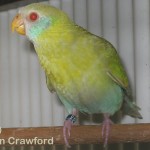
Some food for thought
1. The supplying of any vegetable leaves that the hooded will eat, and you will be surprised what they will eat when they are breeding. These vegetable leaves eg Kale, Broccoli, Dandelion Greens, are rich in calcium and magnesium. Both these minerals need to be balanced, some say at a calcium–magnesium ratio of say 2 to 1. If there is not enough magnesium in the bird’s body it may cause a calcium deficiency. Why? Because if there is not enough magnesium in the bird’s body it won’t adequately use all the calcium available to it.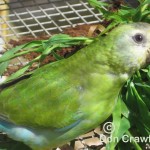
2. The importance of vitamin D3, also for the absorption of calcium, which can be made naturally by direct access to the sun’s ultraviolet rays.
3. The use of cuttlefish and calcium bells, have little if any benefit to your calcium program and should not be used as the only major calcium food. Additives like liquid calcium added to your program are a must.
4. Feeding of Crushed Oyster Shell – This is a marvellous additive being widely used today for the improvement of bird’s health. If there is not enough calcium in the blood, the bird will take the calcium from the bones, creating long-term health problems. Oyster Shell is absolutely full of Calcium Carbonate, which is the white part of the shell; the pink parts are full of Iodine and Magnesium. These foods are a win-win for the bird’s health and a guarantee for the happiness of the breeding hens.
Be Very Aware!
Oyster Shell although a marvellous additive, is not without its problems! “Unrefined” Oyster Shell if not in a clean and refined state maybe contaminated with Lead, Arsenic, Mercury and Cadmium so be aware of these poisons if you’re purchasing “Unrefined” Oyster Shell.
Back to Top
After the hen has been sitting for about 20 days, the eggs will start to hatch. You won’t see the hen in this first week. She will be glued to the hatchlings but the cock is very different, letting you know of his proud achievement. He will fly from perch to perch displaying and dancing on top of the nest box. This display of proudness is just great to see.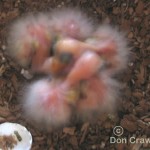
When the eggs hatch and the babies start to grow they become very demanding for more food so we increase the greens and sprouts. If they will eat it, we feed it. And again the cock bird takes the major role, working tirelessly to feed his family. No matter how many times a day you pass his cage, he will be waiting by the food bowl in anticipation that it may again be feed time.
Well-fed young birds grow very quickly and in just over a month they are fully feathered and ready to leave the nest. Both cock and the hen feed the young until they are independent. At this time we remove the young birds to a holding cage so that the parent birds will go back to nest. If the young are left with the parents too long the probable result for that nest will be infertile eggs.
Nesting up to three times per year
There are two parts to my Hooded breeding season, they do nest twice at the early part of the season, then stop as if they were being rewarded with a break of some four weeks. Then they start a late nest while in great condition and fully recovered from the previous two nests.
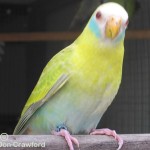 As the Hooded is from the Tropical North of Australia, they breed in the winter months just to escape the intense summer heat that is the major downfall to their chosen breeding area. For some bird breeders the winter is not a popular time to breed birds, as most breeders don’t live in the Tropics and suffer very cold uncomfortable winters. So to breed the Hooded in these cold areas, you must give the Hooded an environment they need and they will breed; that is to create a breeding area that these birds will be comfortable in, and it’s really not that difficult. Changes like insulated nest boxes protect the aviary from the prevailing bad winter weather. Most importantly insulate the roof, which is equally important for the summer as well as the winter. These small changes will give you Hooded breeding success. (You can’t breed Penguins from the Southern Hemisphere in an unnatural high temperature areas unless you give them what they need to survive, for the Penguin it’s their natural cold environment, which is the only way to make them very happy and breeding in their new habitat).
As the Hooded is from the Tropical North of Australia, they breed in the winter months just to escape the intense summer heat that is the major downfall to their chosen breeding area. For some bird breeders the winter is not a popular time to breed birds, as most breeders don’t live in the Tropics and suffer very cold uncomfortable winters. So to breed the Hooded in these cold areas, you must give the Hooded an environment they need and they will breed; that is to create a breeding area that these birds will be comfortable in, and it’s really not that difficult. Changes like insulated nest boxes protect the aviary from the prevailing bad winter weather. Most importantly insulate the roof, which is equally important for the summer as well as the winter. These small changes will give you Hooded breeding success. (You can’t breed Penguins from the Southern Hemisphere in an unnatural high temperature areas unless you give them what they need to survive, for the Penguin it’s their natural cold environment, which is the only way to make them very happy and breeding in their new habitat).
And now by natural occurrence, we have a variety of very interesting mutations some of which belong only in Australia which is quite unusual, as the majority of mutations bred from Australian birds are normally first seen in European aviaries because of their smaller gene pool. To date we have:
- some very nice recessive pieds:
- a dominant pied, having a single and double factor inheritance;
- the recessive red eyed fallow, a beautiful feathered bird which we have been credited with developing over the many years
- the newer olives, not available here as yet
- and the blue which amazingly turned up in three different states, all in the same breeding season. Disappointingly, some blues have faded into a bluey-green wash. Even so, with a little luck and the breeding of the right blue combinations, this very attractive colour should be easily established and could be used for the breeding of a second mutation with some of the already established hooded parrot coloured forms.
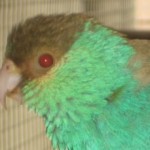
The hooded parrot has been my passion for many years, and the subtle difference between it and other parrots is what has kept my interest and breeding birds without a challenge to me is meaningless.
Adieu,
Don Crawford
